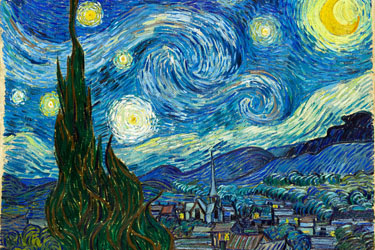The intensity of Van Gogh’s messianic vision, and the restorative powers he sought, and found, in his painting, underlie the deeply expressive character of many of his late works, especially “Starry Night.”
 Van Gogh once described the hushed hours of the night as being “more alive and richly colored than the day,” and he resolved early on to use vibrant color to capture the depth and stilled poetry of its darkness. A tradition of twilight and nocturnal scenes, well established in 17th-century Netherlandish art, had inspired such dark, earlier Dutch masterpieces as his “Potatoes Eaters,” and it resonated as well in the brilliant, gas-lit cafes and moon-lit city streets Van Gogh painted in France. Likewise, the scale and format of many Baroque Northern landscapes — in which expansive, panoramic skies dwarf the human subject and imbue nature with a profound spiritual significance — provided a vision of landscape he carried with him to Provence. And in the image of a sweeping, illuminated night sky unleashed across a narrow band of shaded ground, a subject that reaches its plentitude at St.-Remy, Van Gogh created not only a composite memory of his artistic heritage but his own evocation of an “exalting and consoling nature,” as he described it, that transcended it as well.
Van Gogh once described the hushed hours of the night as being “more alive and richly colored than the day,” and he resolved early on to use vibrant color to capture the depth and stilled poetry of its darkness. A tradition of twilight and nocturnal scenes, well established in 17th-century Netherlandish art, had inspired such dark, earlier Dutch masterpieces as his “Potatoes Eaters,” and it resonated as well in the brilliant, gas-lit cafes and moon-lit city streets Van Gogh painted in France. Likewise, the scale and format of many Baroque Northern landscapes — in which expansive, panoramic skies dwarf the human subject and imbue nature with a profound spiritual significance — provided a vision of landscape he carried with him to Provence. And in the image of a sweeping, illuminated night sky unleashed across a narrow band of shaded ground, a subject that reaches its plentitude at St.-Remy, Van Gogh created not only a composite memory of his artistic heritage but his own evocation of an “exalting and consoling nature,” as he described it, that transcended it as well.
From the barred window of his makeshift studio, Van Gogh had no view of the landscape surrounding the asylum. Uncharacteristically, he summoned his imagination instead, painting an ecstatic vision of the village under a fulgent canopy of stars and a crescent moon. A deep blue backdrop of mountains rises to an undulating crest at right, gathering momentum from the repeated, curved strokes of the painter’s brush that measure the tsunami-like swells. These mountains bear little relation to the stony range of the Alpilles that stretched behind St.-Remy, one that Van Gogh had captured in plein air in other views. Nestled at the mountains’ base in the painting are tight coils of a paler greenish-blue, which depict an orchard illuminated by the night sky, and these give way to the cadenced geometry of the village.


